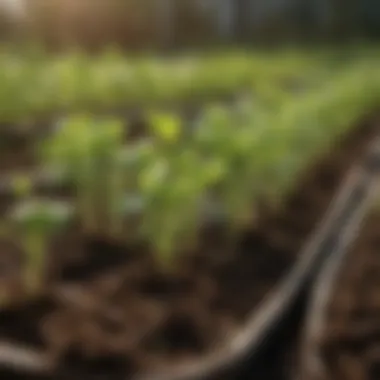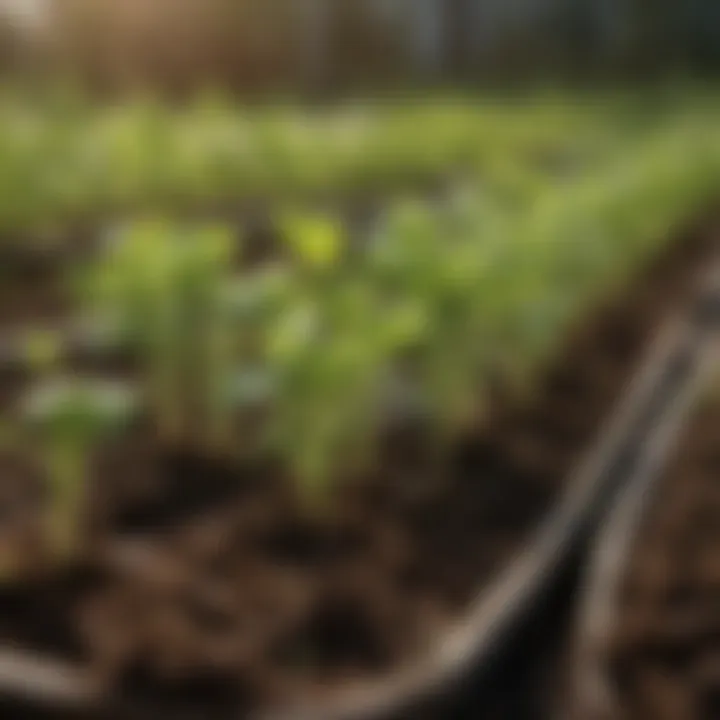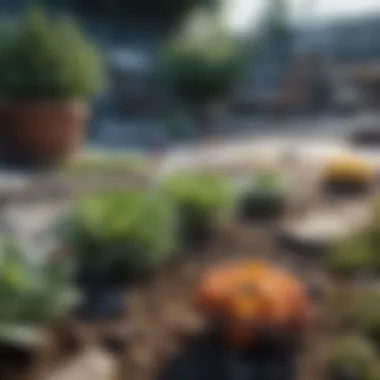Essential Guidelines for Outdoor Vegetable Planting


Intro
Planting vegetables outdoors can be a rewarding endeavor. However, it requires careful planning and consideration. Understanding the optimal times for sowing seeds based on local climate factors is crucial for successful yields. This not only includes knowledge about frost dates but also entails being aware of soil temperature and seasonal variations. For aspiring gardeners, knowing when to plant different vegetables can significantly enhance the potential for growth and harvest.
This guide will delve into essential aspects of outdoor vegetable planting. It will examine the critical factors influencing planting schedules, catering to both novice and seasoned gardeners. By synthesizing various guidelines, this article aims to empower readers to make informed choices about their gardening strategies.
Understanding Climate and Frost Dates
Climate plays a monumental role in determining when to plant vegetables. Different regions exhibit distinct climate conditions that can greatly affect seed germination and growth rates. Here are a few factors to consider:
- Frost Dates: Understanding first and last frost dates for your area is vital. A simple online search or local extension services can provide this information. The goal is to plant seeds after the last frost in spring and before the first frost in fall.
- Soil Temperature: Each vegetable type has an ideal soil temperature range for planting. For example, beans prefer warmer soil, while leafy greens can thrive in cooler conditions. A soil thermometer can help gauge the temperature for precise planting.
"Timing your planting according to frost dates and soil temperature promotes healthier plants and better yields."
Garden Planning Strategies
When starting an outdoor garden, planning is essential. Here are some strategies to consider:
- Zone Identification: Identify your USDA Plant Hardiness Zone, which provides a clear guideline for which plants will thrive in your climate.
- Succession Planting: This technique involves planting new crops at intervals to ensure a continuous harvest throughout the growing season.
- Crop Rotation: Changing the types of crops grown in a specific area each year can help improve soil health and reduce pest issues.
Plant Selection
Choosing the right vegetables to grow can be a daunting task. Beginners often benefit from starting with easy-to-grow varieties. Consider the following suggestions:
- Lettuce: Grows quickly and can be harvested multiple times.
- Radishes: Fast germination makes them ideal for first-time gardeners.
- Tomatoes: A favorite among many gardeners, they offer high yields.
As you become more experienced, experimenting with different vegetables can lead to more diverse and exciting harvests.
End
The outdoors offers a canvas for growing a variety of vegetables. With proper knowledge about planting timings and techniques, any gardener can transform their outdoor space into a thriving vegetable garden. Careful planning, understanding local climate conditions, and making informed decisions about plant selection all contribute to successful gardening. Armed with these guidelines, readers can embark on their journey to cultivate and enjoy the fruits of their labor.
Understanding Planting Seasons
Understanding planting seasons is essential for any gardener aiming to cultivate vegetables successfully. This section outlines the key elements of growing seasons, seasonal planting significance, and regional variations that impact when vegetables can thrive. By grasping these concepts, gardeners can enhance the potential for a better harvest.
Defining the Growing Season
The growing season is defined as the period in which conditions are favorable for plant growth. Typically, it is measured from the last frost date in spring to the first frost date in autumn. For many vegetables, this time is crucial, as temperature and weather impact seed germination, growth rates, and pest susceptibility. Understanding this timeframe is vital for ensuring that plants receive enough heat and light, which are both fundamental for optimal growth. For instance, cool-season crops like spinach and broccoli thrive in the cooler months, while warm-season vegetables such as tomatoes and peppers require warmer temperatures that occur later in the year.
Importance of Seasonal Planting
Seasonal planting plays an integral role in maximizing crop yield and health. Different plants have varying temperature and light requirements, which means that timing can greatly influence their growth and production. Planting out of season may lead to poor harvests, increased pest problems, and wasted resources. For example, starting warm-season vegetables too early can expose them to frost damage. Hence, knowing when to plant specific vegetables can save time, effort, and resources while boosting garden productivity. Furthermore, aligning planting schedules with natural seasonal changes fosters biodiversity in the garden ecosystem.
Regional Differences in Growing Seasons
Growing seasons are not uniform; they vary greatly across different geographical regions due to climate variations. Locations with milder winters may have longer growing seasons. In contrast, areas with harsh winters experience shorter growing windows. For example, gardeners in USDA Hardiness Zone 5 typically have a shorter growing season than those in Zone 9.
Understanding local climate conditions is essential for choosing the right vegetables and timing their planting. Knowledge of microclimates, such as shaded areas or regions with heavy winds, further informs how a typical growing season may shift for individual gardens. Gardeners should refer to local resources, such as agricultural extensions or community gardening groups, for specific advice tailored to their regions.
"Local climate knowledge can transform a garden's success, leading you to plant at just the right time for maximum yield."
Through this understanding of planting seasons, gardeners can better prepare their gardens, select appropriate crops, and ultimately increase satisfaction and productivity in their vegetable planting endeavors.
Climate Considerations
Understanding the climate is essential for successful vegetable planting. Different plants thrive under specific climatic conditions. When gardeners consider climate variables, they can ensure that their chosen vegetables grow optimally, increasing the likelihood of a healthy yield. Factors like temperature, humidity, and precipitation affect plant growth significantly. Ignoring these aspects may lead to poor growth or crop failure.
Understanding Hardiness Zones
Hardiness zones are a classification system that indicates which plants can survive and thrive in particular climates. The United States Department of Agriculture (USDA) developed this system, dividing North America into zones based on the average annual minimum temperature.
Knowing your hardiness zone helps gardeners select suitable vegetables. For example, a zone that experiences harsher winters may not support delicate plants like tomatoes. Instead, they should opt for more robust varieties able to withstand cooler conditions. Additionally, each zone has specific planting and harvesting times.
Benefits of Understanding Hardiness Zones:
- Accurate Plant Selection: You can choose plants suited for your zone.
- Informed Timing: Knowing when to plant and harvest enhances success.
- Season Extending Strategies: Some methods, like using row covers, can extend the growing season in chillier zones.


Impact of Microclimates
Microclimates are small areas where the climate differs from the surrounding area. These differences can result from geography, structures, or vegetation. Understanding microclimates allows gardeners to optimize their planting strategies.
For instance, a garden located next to a brick wall may retain more heat than one in an open area. This characteristic can benefit heat-loving plants. Likewise, shaded areas might be suitable for cool-season vegetables.
Key Considerations for Microclimates:
- Temperature Variations: Identify warmer or cooler spots in your garden.
- Wind Protection: Physical barriers can shield plants from harsh winds, impacting growth.
- Soil Moisture: Areas with better drainage or moisture retention can benefit specific vegetables.
"Identifying microclimates in your garden can lead to more efficient planting and better yields."
Successful vegetable gardening requires an understanding of the climate, including hardiness zones and microclimates. By factoring in these elements, gardeners can create a thriving outdoor vegetable garden.
Frost Dates and Their Significance
Understanding frost dates is crucial for a successful vegetable garden. These dates determine when it is appropriate to plant seeds outdoors and when to harvest them. Frost can damage or kill plants, particularly tender varieties. Knowing the last frost date in spring and the first frost date in fall helps gardeners schedule their planting effectively.
By taking frost dates into consideration, gardeners can maximize their growing season. This knowledge reduces the risk of crops being lost to unexpected frosts, ultimately leading to better yields and healthier plants. Additionally, planning around these dates allows for greater variety in what can be grown each year.
Determining Last Frost Dates
The last frost date is the final time in the spring when frost is expected in a specific area. It varies by region and can change yearly. To determine this date, gardeners can consult local agricultural extensions, gardening websites, or historical data. Consideration of microclimates—areas that experience slightly different weather patterns—can also play a role in establishing a more precise last frost date for a particular garden.
Many online tools and gardening apps provide forecasts based on zip codes and local weather patterns.
Understanding First Frost Dates
The first frost date signifies the onset of colder temperatures in the fall. Like the last frost date, it varies significantly depending on geographic location. Knowing this date is critical for initiating the end-of-season tasks in the garden. Many gardeners begin to prepare their plants for the colder weather once they know this date.
This time is also vital for ensuring that mature vegetables are harvested before frost can damage them. Similar resources can be used to find this date, such as local farmer's almanacs and community gardening websites.
Strategies for Mitigating Frost Risks
While gardeners cannot control the weather, they can take steps to reduce frost risks. Here are several strategies:
- Use Row Covers: Lightweight fabric can protect plants from frost. It traps heat, providing a few extra degrees of warmth.
- Mulching: A layer of organic material can help insulate the soil and maintain a higher temperature in the root zone.
- Planting Late-Varieties: Some vegetable types are bred to mature quicker. Choosing these varieties can help avoid late frosts.
- Strategic Location: Positioning plants in areas that benefit from morning sun can help them warm faster after a frost.
Utilizing these strategies ensures that gardeners can extend their growing season and enjoy the benefits of a productive harvest.
Soil Temperature and Its Role
Soil temperature plays a crucial role in the overall success of your vegetable garden. It influences seed germination, root development, and even nutrient uptake. Knowing the right soil temperature helps you optimize planting time, thereby enhancing the growth and yield of your crops. Cold soil can lead to slow germination, while excessively warm soil can cause seeds to die before they sprout. Therefore, understanding soil temperature is essential for any gardener seeking to cultivate a thriving vegetable patch.
Ideal Soil Temperature for Various Vegetables
Different vegetables have unique temperature requirements for optimal growth. Cool-season crops, such as lettuce, carrots, and peas, prefer soil temperatures between 45°F to 65°F. These vegetables can be planted early in the spring or late in the summer for a fall harvest.
On the other hand, warm-season vegetables, like tomatoes, cucumbers, and peppers, thrive in temperatures ranging from 60°F to 75°F. Planting these crops too early in cold soil can result in poor germination rates and stunted growth. It is advisable to wait until the soil temperature warms sufficiently to ensure healthy plants.
Methods for Measuring Soil Temperature
Measuring soil temperature accurately is important for timing your plantings effectively. Here are several methods you can use:
- Soil Thermometers: These are specialized tools designed to measure soil temperature at various depths. Simply insert the thermometer into the soil to get a reading.
- Infrared Thermometers: These devices measure the surface temperature of the soil without direct contact. This can be useful for quick checks but may not reflect the soil temperature deeper down.
- DIY Methods: You can also use simple probes made of metal, inserting them into the soil to feel for warmth or chill. While not as precise, it can still give a general idea of the condition.
Temperature Guidelines for Seed Germination
Understanding the seed germination temperature is critical. Each species of vegetable has specific temperature ranges conducive to germination. Here are a few guidelines:
- Lettuce: Germinates best between 45°F and 75°F. Recommended to plant in early spring.
- Radishes: For optimal germination, temperatures should be around 50°F to 85°F.
- Beans: Require warmer soil, ideally between 70°F and 90°F for successful sprouting.
By following these temperature guidelines, you ensure better rates of germination and strong healthy seedlings. Additionally, monitoring soil temperature will minimize the risks associated with extreme conditions, enabling a more fruitful gardening experience.
"Soil temperature is the silent architect of your vegetable garden. It quietly dictates growth patterns and health, requiring careful monitoring and attention."
Choosing the Right Time to Plant
Selecting the proper time to plant vegetables is a critical factor for successful gardening. Timing affects growth rates, crop yield, and overall plant health. Understanding when to plant not only maximizes your garden's potential but also helps ensure that the plants thrive. Different vegetables have specific needs and preferences regarding temperature and soil conditions. Hence, it is essential for gardeners to know the general guidelines for either cool-season or warm-season vegetables.


Timing for Cool-Season Vegetables
Cool-season vegetables include crops such as lettuce, spinach, and peas. They thrive in the cooler temperatures of spring and fall. Typically, these vegetables should be planted when soil temperatures are consistently between 40°F to 75°F.
It's advisable to start planting these vegetables in early spring. This allows crops to grow quickly before summer heat sets in. In many regions, this means planting as early as March or April, depending on local frost dates. Another option is to plant in late summer for a fall harvest, usually around August or September.
Follow the advice below:
- Direct Sowing: Many cool-season crops can be directly sown into the garden as soon as the soil is workable.
- Transplanting: Some gardeners choose to start seeds indoors about 4-6 weeks before the last expected frost. Transplanting when seedlings are strong will also yield better results.
It's crucial to monitor local conditions. Sudden temperature spikes can damage seedlings.
Timing for Warm-Season Vegetables
Warm-season vegetables like tomatoes, peppers, and cucumbers require warmer soil and air temperatures to flourish. Planting these types should occur when the soil temperatures rise to at least 70°F at a depth of about 2 inches.
Typically, warm-season crops are planted after the last expected frost date in your area. This usually occurs between late May and early June, depending on regional differences. However, in warmer climates, one can start earlier, even in April.
Consider these points for warm-season plants:
- Transplants: Using seedlings that have been started indoors can jumpstart the growing process. This method is especially beneficial for slow-growing plants like peppers.
- Soil Preparation: Ensure that soil conditions are right. Warm-season vegetables need rich organic matter and well-draining soil.
In summary, timing for both cool-season and warm-season vegetables is vital. Evaluate your local climate, frost dates, and soil temperatures to make the best decisions for a productive garden.
Remember to keep a gardening journal to track your planting dates and assess what works best in your specific environment.
Methods for Starting Vegetables
Starting vegetables effectively is essential for any outdoor planting endeavor. The method you choose can greatly affect growth rates, yield, and overall plant health. Understanding the differences between various approaches allows gardeners to optimize their strategies. Each method has its unique advantages and challenges, and selecting the right one is crucial depending on your specific gardening environment and the vegetable types you intend to grow.
Direct Sowing vs. Transplanting
Direct sowing involves planting seeds directly into the soil where they will grow. This method is often preferred for crops like carrots or radishes, which do not respond well to transplanting. The benefits of direct sowing include:
- Simplicity: It requires less initial setup compared to transplanting.
- Less stress for seeds: Seeds germinate in their final location, avoiding transplant shock.
- Lower cost: Fewer resources are needed, as you do not need seedling trays or pots.
However, it also comes with challenges. Weather conditions can directly affect germination and early growth. For instance, heavy rains might wash away seeds, or dry spells could delay germination.
On the other hand, transplanting involves starting seedlings in controlled environments (like inside your home) and later transferring them to the garden. This method is best suited for larger crops such as tomatoes or peppers. Benefits of transplanting include the following:
- Stronger starts: Seedlings are nurtured with ideal conditions before facing the outdoor elements.
- Extended growing season: Transplanting can allow for earlier harvests, as seedlings can be nurtured indoors while outdoor conditions remain cold.
- Better control over spacing: You can better plan where each plant will grow, reducing crowding.
Nevertheless, transplanting requires more careful timing and handling to avoid stress on the plants during the transfer.
Indoor Seed Starting Techniques
Indoor seed starting is a favored technique for many progressive gardeners. This approach supports earlier growth and allows for better control over the environment. Here are key components of the technique:
- Containers: It's essential to choose containers that promote good drainage. Options such as seedling trays or biodegradable pots are popular.
- Growing Medium: A high-quality seed starting mix with good drainage and nutrients is critical for seedling health.
- Lighting: Providing sufficient light is vital. Many gardeners use grow lights to replicate conditions similar to outdoor sunlight.
- Temperature: Maintaining warmth encourages germination. Most vegetable seeds prefer a temperature of 65-75°F (18-24°C).
- Watering: Consistent moisture is necessary, but overwatering must be avoided. A spray bottle can help control hydration without excessive saturation.
Starting seeds indoors offers a head start, especially for regions with short growing seasons. However, it requires attention and care to ensure seedlings are healthy enough for life outside.
"Transplanting is not just an artisanal craft but also a science that, when done correctly, yields impressive results for your garden."
Ultimately, the methods for starting vegetables are significant to successful outdoor gardening. Understanding and integrating direct sowing, transplanting, and indoor seed starting techniques will ensure that plants have the best possible chance for thriving in their new environment.
Monitoring Weather Conditions
Monitoring weather conditions is a cricial aspect of successful vegetable gardening. The fluctuating weather can directly impact planting and cultivating strategies, which can influence overall crop yield. Understanding temperature changes, rainfall forecasts, and wind patterns can help a gardener make informed decisions about when to plant seeds and transplant seedlings.
By keeping track of the weather, gardeners can anticipate challenges. For instance, sudden temperature drops or excessive rainfall may require protective measures, such as covering plants or altering watering schedules.
Additionally, understanding weather patterns allows for better planning. It can help in deciding which vegetables are suitable for a particular season, leading to a more productive garden.
Online Tools for Weather Monitoring
Various online tools can aid gardeners in tracking weather conditions. Websites and mobile applications provide forecasts that are specific to local areas. Many of these platforms offer vital information, such as:


- Temperature forecasts: Knowing the expected temperature range helps in selecting the right planting days.
- Precipitation levels: Understanding potential rainfall can prevent overwatering or missing out on watering during dry spells.
- Frost alerts: Timely notifications on frost threats can protect tender plants by giving the gardener a chance to act.
Some recommended tools include Weather Underground and AccuWeather. These resources provide accurate, real-time updates and long-term forecasts.
Understanding Weather Patterns
Recognizing weather patterns is essential for effective vegetable gardening. Patterns like prevailing winds, humidity levels, and seasonal rainfall can greatly affect plant health and growth.
For example, in regions with consistent rain in spring, it is wise to anticipate soil saturation. This can lead to root rot in vulnerable plants if planting is not timed correctly. Similarly, areas prone to drought demands careful scheduling and efficient irrigation strategies.
Additionally, trees and structures can create microclimates, which may exaggerate or dampen weather conditions, impacting how and when different vegetables thrive.
In summary, comprehending weather dynamics allows gardeners to adapt and strategize, ensuring that planting efforts are maximized for optimal growth.
Sustainable Practices in Planting
Sustainable practices in planting are crucial for those involved in vegetable gardening. They ensure that gardening activities do not only yield produce but also support the ecosystem in a balanced manner. Engaging in sustainable planting can optimize soil health, conserve water, and promote biodiversity. These practices also reduce reliance on chemical fertilizers and pesticides, which can degrade the environment over time.
By implementing sustainable practices, gardeners can create a more resilient garden. This resilience allows plants to better cope with climate stresses and pest pressures. Additionally, sustainable practices promote soil health and support its structure, which is vital for efficient root growth.
Leveraging Local Practices
Local agricultural practices can vary greatly depending on geographical and climatic factors. It is beneficial for gardeners to learn from their local environments and utilize methods that have evolved to suit their specific conditions.
Incorporating local knowledge can enhance the chances of gardening success. For instance, certain regions may have specific crop rotation strategies that maintain soil nutrients and minimize disease.
To leverage local practices, gardeners should:
- Engage with local extension services: These services often provide research-based advice tailored to specific locations.
- Participate in community gardening groups: This fosters knowledge sharing among seasoned gardeners and novices.
- Attend local workshops and seminars: These events introduce innovative local approaches and techniques.
Understanding these elements can lead to better planting decisions that suit the specific needs of the environment.
Companion Planting Techniques
Companion planting is an ancient practice that involves growing different plants close together for mutual benefits. This technique can lead to improved growth, flavor enhancement, and pest control.
Certain plants, when grown together, can enhance each other’s growth and even ward off pests. For example, tomatoes and basil are known to thrive together. The basil can help deter pests that typically affect tomatoes while enhancing their flavor.
Some key considerations for companion planting include:
- Pest Control: Certain plants can repel harmful insects, providing a natural alternative to pesticides.
- Nutrient Sharing: Some plants can improve soil quality and provide beneficial nutrients to their neighbors.
- Space Efficiency: By growing compatible plants together, gardeners can maximize their garden space.
"Sustainable gardening practices are essential for protecting our planet and preserving our natural resources."
By engaging in these practices, gardeners contribute to a more sustainable future.
The End: Planning Your Garden
Planning your garden is a crucial step in achieving successful vegetable growth. This process ensures that all elements are in harmony with each other. Understanding key factors like climate, soil conditions, and planting schedules is vital. By considering these aspects, gardeners can create an optimal environment that maximizes growth potential and yields.
The considerations involved in planning are not merely logistical; they have direct consequences on the health of the plants. For instance, planting at the right time prevents potential setbacks associated with pests and diseases. Additionally, gardens that follow planned schedules tend to use resources more efficiently, leading to sustainable practices.
Efficient planning involves assessing local conditions, which may vary significantly even within small geographic areas. Recognizing regional differences can immensely benefit any gardener looking to thrive.
Summary of Key Factors
Several elements play a significant role in the planning process:
- Climate: Understanding local climate conditions can guide what vegetables to plant and when.
- Soil Quality: Regular testing can help ensure the nutrients are adequate for vegetable growth.
- Frost Dates: Knowing both last and first frost dates can prevent damage to tender plants.
- Water Availability: Planning for adequate watering, especially in dry months, is essential for plant health.
These factors combined create a foundation for a successful garden.
Creating a Planting Schedule
A well-structured planting schedule is the backbone of garden planning. It serves as a roadmap for when to sow seeds or transplant seedlings.
Here are some steps to create an effective planting schedule:
- Research Vegetable Varieties: Each type of vegetable has unique requirements. It helps to know the best planting time for your chosen varieties.
- Catalog Frost Dates: Keep track of the last frost date in spring and the first frost date in fall for your specific area.
- Write Down Ideal Planting Times: Create a list that specifies when to plant each vegetable based on the frost dates, ensuring proper growth conditions.
- Adjust for Regional Differences: Consider local climate variations when planning your schedule.
Having a planting schedule not only alleviates confusion but also ensures that each plant receives the adequate attention it needs for successful growth.
"Understanding your garden's unique needs is the key to unlocking its full potential."
This comprehensive approach to planning significantly enhances the potential for a fruitful gardening experience, offering both satisfaction and sustainable results.



